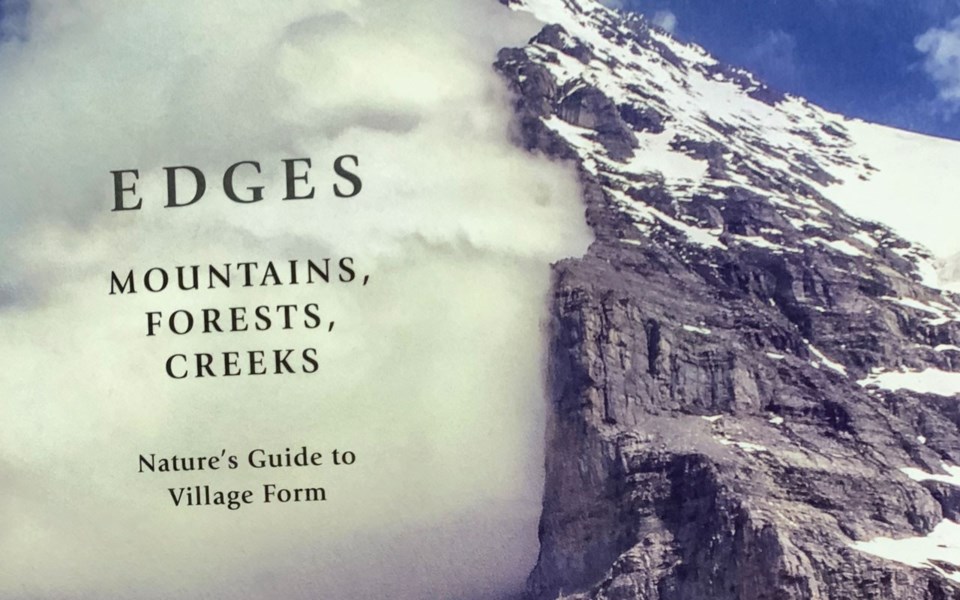The landscape architect behind Whistler Village has always been fascinated by edges.
"Life is richer at the edges—sunlight meets shadow, meadow meets forest, sidewalks meet storefronts, people meet people and people meet nature."
That's the first line in the preface of Eldon Beck's new book, Edges: Mountains, Forests, Creeks, Nature's Guide to Village Form. "It was a long time coming," Beck says of the book, which was published earlier this year. "In part of my design world, I've had a fascination with the edges of surfaces where things come together. The natural landscape has been my textbook."
The book mixes pictures, poetry, and anecdotes, all woven together by the overarching theme of edges in nature and design. It's broken down into five parts: Sun's Light, looking at sunlight as a "guiding force;" Gore Creek: My Ecotonal Mentor, which examines how a creek in Vail, Colo. influenced Beck's concept for designing villages—in particular, pedestrian lanes; Peaks to Shore: Continents, Edge to Edge, exploring how one habitat connects to the next; Alpine Settings: Villages and Buildings, highlighting alpine settlements; and Three Villages: Distinct Yet Alike, looking at the similarities between Interlaken, Switzerland, Mill Valley, California, and Whistler.
"The book, without knowing it, began to form I don't know how many years back," Beck says. "I started putting it together under the topic of edges ... and worked on that for about a year. Then finally the form of the book began to be interesting. At first I hadn't thought a lot about having it highly illustrated with lots of pictures, but it became evident that the best way for me to communicate a theory was to talk about it and to show it."
For Whistlerites, perhaps the most compelling part of the book is all the insight it offers into the construction of Whistler Village back in the mid-1970s.
Beck was the landscape architect tasked with working with the Resort Municipality of Whistler (RMOW) to design Whistler Village. As he explains in the book, the very first RMOW council, led by Mayor Pat Carleton, provided broad guidelines on what the village should look like, but as part of that guidance, he prioritized things like a pedestrian-friendly area with no vehicles, small buildings adjacent to public spaces so local residents could buy parcels, and putting retail shops and restaurants on the ground floor and tourist accommodation on upper levels.
"In all seasons, the Town Centre was to serve the local residents as well as visitors," he writes in the book. "It was to appeal to all ages, to the world-wide audience."
Another goal that he highlights is connecting the village to the mountain in a "convenient and dramatic" way to offer "the sense that the mountains were permitted to flow into the village."
"I believed the village's relationship to the mountain went beyond physical access. The link was a spiritual connection: the mountains are places of adventure and mystery where every person could search for meaning," he writes.
While Beck lives in California, when he comes back to Whistler and walks down the Village Stroll there are aspects that panned out as he envisioned and some that didn't.
Village Square to Mountain Square, for example, has had trees removed and never replaced. And Mountain Square itself "never really evolved into the public place that's interesting and exciting," he says. "I'd always hoped to see it full of tables, full of people."
But the biggest success, which he also highlights in the book, is Whistler Olympic Plaza, he says. "That's become an absolutely wonderful place," Beck says. "It is really so precious because in its form now, as a product of the 2010 Olympics, with the Olympics leaving electrical and sound systems there that were worth millions of dollars, they're able to be used for the stage and operation there now ... The voice of the community was heard loud and clear—create it is a natural place, not a business venture that people can use spontaneously. Maybe that's the beauty of it."
In the book, he concludes the section on Whistler by drawing comparisons, once again, between the shape of nature and design.
"The indefinable spirit of Whistler Mountain flows into the inescapable aura of Village Stroll, and the narrow corridor unites with the broad slopes of the mountain," he writes. "The form of the Village, its spaces, buildings and shapes of roofs, find harmony with forms visible throughout nature. The forest is the grand connector. Edges in the village find companionship with edges of mountains, forests and creeks."
Edges: Mountains, Forests, Creeks is available at Armchair Books and the Whistler Museum.




